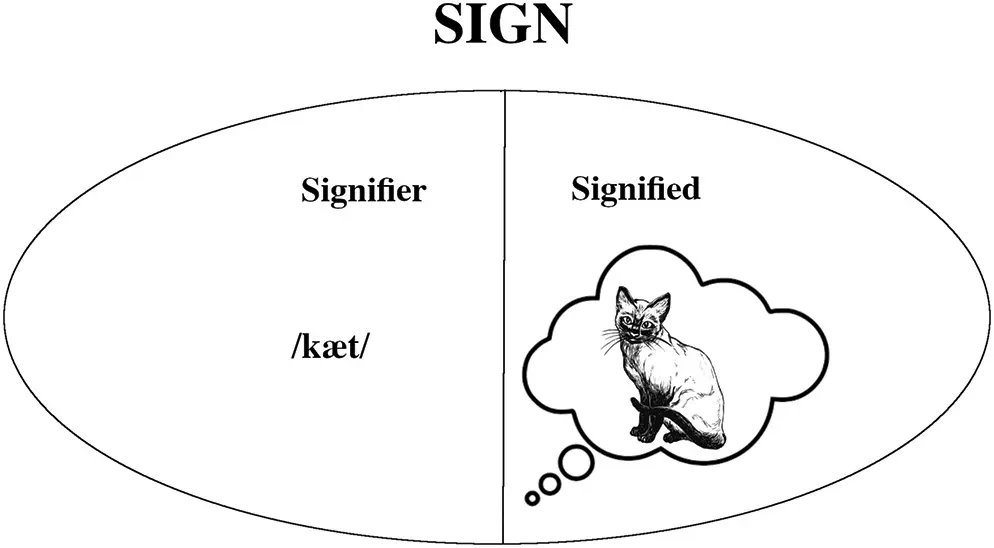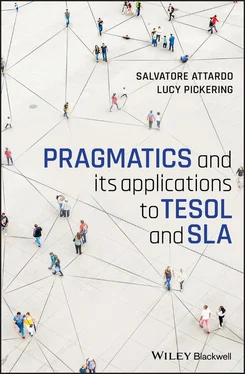Typographical Conventions
Numbered examples are set apart, whereas un-numbered examples appear in the running text in italics, as for example in the present example . Translations appear in single quotes following the original. Grammatical constructions appear in small caps, for example, leave X alone. Mentioned words appear in double quotes: “boy” has three letters. The use/mention distinction
(1) The boy kicked the ball (use/object)
“Boy” consists of three letters (mention/metalanguage)
is parallel to the object language versus metalanguage (see Metalanguage and Object Language section of Chapter 10).
Ungrammatical sentences are marked by a prefixed asterisk (*), whereas pragmatically problematic utterances are marked by the symbol ( ※); contrast
(2) * The children eats breakfast.
※Excuse me sir, would you mind getting out of my face?
Tone units are indicated by double vertical bars, as in the example below
(3) || GRAvy ||
the usual conventions apply:
CAPS indicate the prominent syllable
Rising, falling, and level tones are indicated by , , and , respectively.
Tone markings precede the tonic syllable: || GRAvy ||
Cross references within the book are given by chapter, section, and subsection: so a cross reference (see 5.3.2) means chapter 5, section 3, subsection 2.
Let’s start from a very simple, everyday situation, a man walks in a donut store and asks for a donut, for example, by saying: “May I have a donut, please?” The donut shop employee turns around, picks up a donut, and gives it to the man. There are many ways of looking at this situation, but we will focus on just one aspect: How did the man and the donut shop employee know that the uttering the word “donut” would cause the transaction to succeed? 1A simple explanation is that both the man and the employee know that “donut” means a certain kind of pastry made with sweet dough that is deep fried and covered with various glazes, sugar, and/or sprinkles. Furthermore, the man and the employee know that by using the word, they are referring to (i.e., they mean) an object that happens to be in the display case of the shop. However, the word “means” in this explanation is deceptively simple. In fact, a whole discipline, a part of philosophy, deals with the apparently simple idea of “meaning.” Within linguistics, which is our domain, many ideas from philosophical semantics have been adopted but a few come from other fields, as we will see.
Semantics is thus the part of linguistics that deals with meaning. We will start out by defining meaning; to do so, we must introduce the idea of the semiotic sign and of code or, to put it differently, explain how it is possible to mean something using something else. We then introduce two major approaches to semantics: the extensional (referential) approach and the intensional approach. Once we have examined these two radically different ways of approaching semantics, we will examine the contentious issue of the boundary between semantics and pragmatics, which is entwined with the idea of context and of modularity. These are big ideas that exceed pragmatics and even linguistics. However, it is important to understand where pragmatics itself as a science is located, within the context of its two older sisters: philosophy and psychology.
1.1 What Do We Mean by Meaning?
Meaning can be a complex and off-putting topic: many students are discouraged by the difficult terminology and symbolism of logic, which is often used in its presentation, or are confused by the fact that there exist many conflicting theories of meaning, unlike the relative simplicity of morphology and phonology. It does not matter that if you scratch below the surface, both phonology and morphology are as conflicted as semantics. Most students never get the chance to enter semantics.
Conversely, others may feel that there’s nothing to be studied there: after all, “cow” means “cow” and if I say “cow” I mean “cow” and that’s it. What could be simpler? All you would need to teach to a learner of a foreign language would be the vocabulary. Is that a realistic view of language teaching? Of course not. There is much more to speaking a foreign language than plugging in words. In fact, even within a single language, what words convey may change. Consider the sentence: Nice driving! The meaning of the words is very clear: “nice” indicates a positive assessment and “driving” refers to operating and specifically directing a vehicle. However, Nice driving! could be uttered by a spouse to another who has just driven them to the airport in record time at rush hour, or to a spouse who just crashed the car into a tree, causing significant damage to the car. Note how the meaning of the words “nice” and “driving” is not affected at all by the change in situations. What changes is that the speaker means nice literally in the first situation and ironically in the second. So, even assuming that the meaning of words was simple and straightforward (it is not, incidentally!), the meaning of the utterance could change significantly. So, yes, meaning is complicated.
But, what is meaning, precisely? Meaning is the result of an act of semiosis conducted by an agent. 2Semiosis is the process of producing a sign. So, to begin with, meaning is associated with signs. We will discuss precisely how in what follows.
A sign is the union of a signifier and a signified. The signifier is the mental representation of the physical component of the sign, such as a sound, an image, or an alphabetic symbol. The sequence of phonemes /kæt/, the graphemes “cat,” and Figure 1.1 are all possible signifiers of the sign “cat.”

Figure 1.1Image of a cat.
The signified is the mental representation of the entity referred to by the sign. When a speaker of English hears the sounds of the word /kæt/ or reads the letters “cat” or sees Figure 1.1, he/she thinks of a cat (has a mental representation, a concept). That thought is the meaning of the word “cat.”

Figure 1.2 A sign is the union of a signifier and a signified.
So, in a sense, a sign is a tool to connect, via two mental representations, two physical world entities: a group of sounds, that is, the actual pronunciation of a group of phonemes and an actual physical object in the world, the referent (namely, an actual cat, with fur, a tail, whiskers, claws, who has been spayed, goes to the vet on Thursday, etc.). There is no easy way to connect the two without going through a conventional pairing of mental representations (of sounds, graphemes, etc. on the one side, and of referents, on the other). If we put all of this into a graphic representation, we get the so-called semiotic triangle, as shown in Figure 1.2. Note how there is no direct link between the sounds and the referent. The job of the sign is to connect the two (sounds and referents).

Figure 1.3The indirect relationship between the sounds and the referent, mediated by the sign.
There is no reason, except social convention, for a cat to be called a cat or a dog a dog. Consider the fact that a dog is called “dog” in English, “chien” in French, “perro” in Spanish, and “gǒu” in Chinese. If there were a good reason for a dog to be called a dog, then that reason would hold also in China and France. Since it obviously doesn’t, given the variety of terms just considered, then there isn’t one. This is known as the principle of the arbitrariness of the sign.
Читать дальше















